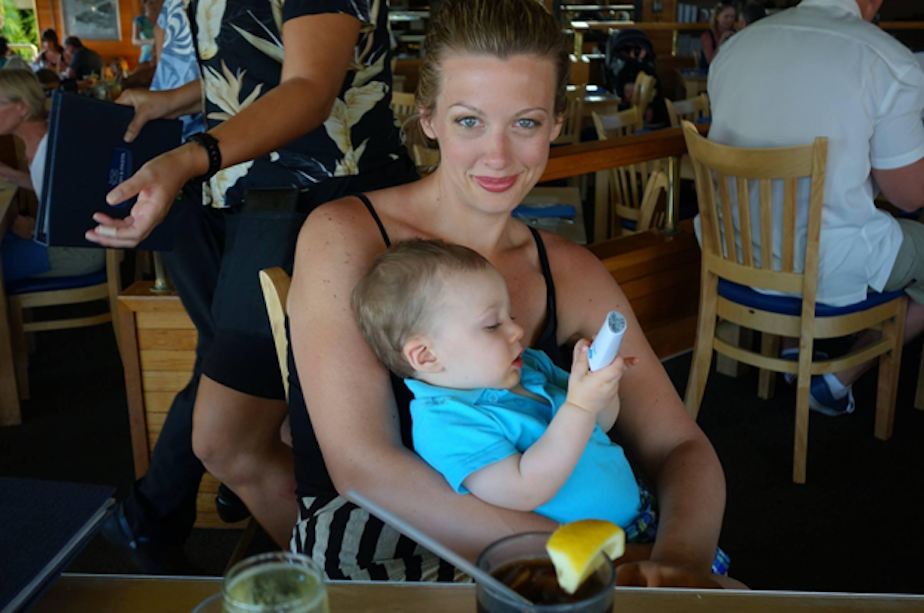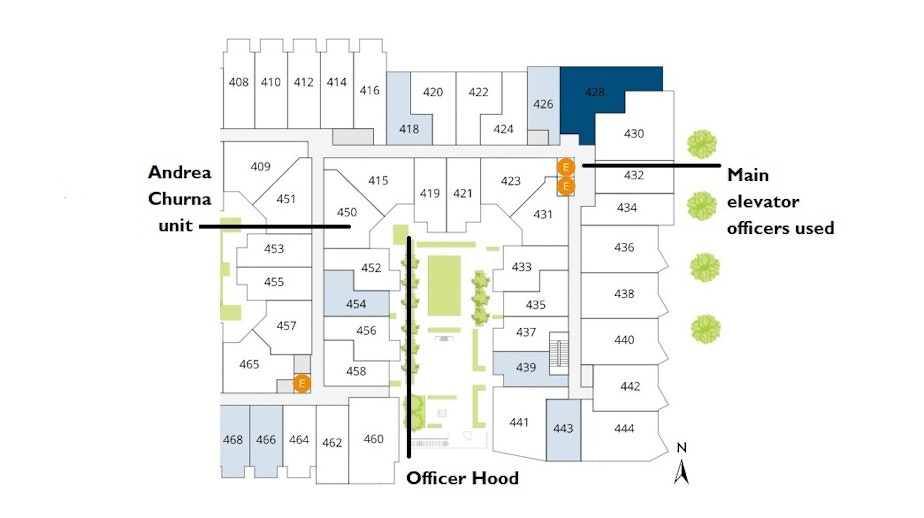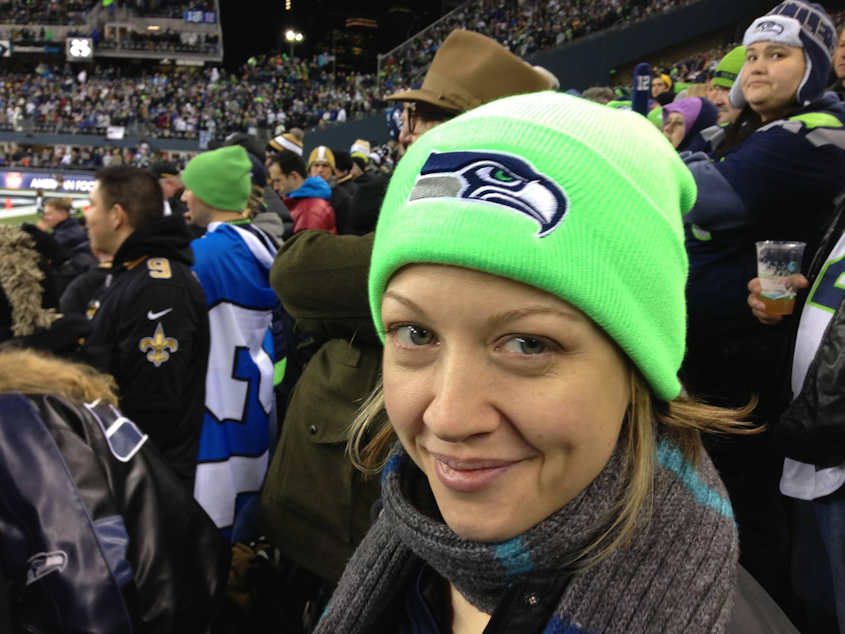This Redmond mom was fatally shot by police after calling 911 for help

When Andrea Thomas Churna moved into her luxury apartment in Redmond, Washington, last summer, she was looking forward to a fresh start. She had recently moved back to Washington state from California, to raise her 7-year-old son with her ex-husband.
One month later, on a balmy fall night, Churna dialed 911. “I think someone’s trying to kill me at my apartment,” Churna told emergency dispatchers at 9:23 p.m. on September 20.
That call would result in her death 30 minutes later. To understand what transpired that night, and why the investigation into this police death has stalled after seven months, KUOW reviewed 911 emergency phone calls, police radio audio, police statements, and spoke with Andrea Churna’s family, and fourth-floor residents who were home that evening.
A
ndrea Thomas Churna, called Andi by friends, worked in human resources for local tech companies. She was the mother of a 7-year-old boy — a child doctors told her she was unlikely to have — and a cop’s daughter. Growing up, her friends’ parents were officers, prosecutors and judges. Churna was taught firearm safety at an early age, and because she was a single mother living alone — and because of a previous stalker — she owned a gun.
That September evening, Redmond police arrived within three minutes of Churna’s 911 call. Officer Brian Hood found her in the apartment building courtyard at 9:46 p.m.; she was hanging from a balcony railing.
Churna told Hood that she was the one who called 911, she didn’t feel safe inside her apartment and that she had shot at someone, Hood wrote in a police statement.
Listen to Andrea Thomas Churna's 911 call
Other officers headed for the fourth floor, where Churna’s apartment was located. Hood relayed to the other officers at the scene that Churna may be having mental health issues.
Hood asked Churna to climb back onto her balcony, and she did, he wrote.
“I then asked Andrea if she had access to a firearm,” Hood wrote in his police statement. “She replied, ‘Yeah,’ and ran inside the apartment simultaneously. I yelled for Andrea to stay outside but it was too late.”
Churna returned to her balcony with a handgun, Hood wrote, and he said she pointed the weapon at him. He told the other officers on scene that she was armed. Hood asked that she put her weapon down, and she briefly ran inside and then returned without the gun. She told Hood that she had placed it on a table inside.
When Hood asked Churna if her front door was unlocked, in case other officers had to enter her apartment, she ran inside to unlock it and returned to her balcony. But as Hood was explaining that it was important for Churna to follow commands, she went back inside her apartment, Hood wrote.
Standing in the hallway outside her front door were officers Ty Tomlinson and Evan Barnard.

Tomlinson radioed that Churna had pointed a gun at him, too. He responded by firing three rounds at Churna, missing her each time. Police later recovered three bullets that had shot through the wall of an empty apartment across the hall from Churna’s unit.
Several residents of the complex called the police after they heard the gunshots, some of them distraught and hunkered down in their units.
A few doors down, in apartment 404, Stefan Blair said he heard shouting and shooting coming from down the hall at about 9:50 p.m. Blair and his girlfriend fled to their bedroom, the room farthest from the hallway, turned the lights off and huddled in the corner.
“It kind of felt like it stopped for a bit,” Blair said of the gunfire.
After being fired at, Churna reappeared on her balcony, Hood wrote in his statement. She was on her phone, talking to her ex-husband.
“I yelled out to ask if she had fired at officers,” Hood wrote. “Andrea told me she did not shoot at them, but that they shot at her. I asked her if she was injured, but she told me none of the bullets struck her.”

Hood asked Churna if she was willing to throw her gun over the balcony, but she said no. She told Hood she would turn herself in to her ex-husband.
At about this time, a sergeant and three more police officers, including one named Daniel Mendoza, arrived in the hallway on the fourth floor outside Churna’s apartment. There were now six officers in her hallway.
Ty Tomlinson, one of the first responding officers, told newer arrivals that he had shot at Churna after she pointed her gun at the officers, according to police records, but he was unsure if he hit her.
The sergeant and one of the officers who had just arrived went downstairs to get a ballistic shield. Downstairs, they met Churna’s ex-husband, Timothy Churna, an attorney for Microsoft. Churna told him that Andrea Churna’s father, a former police officer, had given her the gun, and that he had not thought it was a good idea. He said his ex-wife was “acting paranoid” about being stalked on social media.
Sponsored
Back outside beneath the balcony, Officer Hood radioed his colleagues on the fourth floor that “Andrea was unarmed on her balcony and, if they felt comfortable, it presented an opportunity to enter her apartment and take her into custody while she was distracted.”
Hood wrote that Officer Mendoza replied “they were going to hold their position and wait for a shield.”
That’s when Andrea Churna stepped out into the hallway.
Officer Barnard yelled for her to get on the ground, which she did.
Another officer wrote in his statement that he saw Churna from down the hallway, lying on her stomach, facing away from officers with her hands out to her side and her legs spread apart.
Sponsored
“I looked around the area where she was laying for a weapon and I did not see one in the immediate area,” the officer wrote. The King County Sheriff’s Office Major Crimes Unit would later locate a loaded handgun in Churna’s apartment, according to an October 2020 press release.
Churna, still on the ground, turned her head to look back at officers. She asked about her ex-husband. Officers Mendoza and Barnard told Churna not to move, and said that if she did, she would be shot. Another officer told Churna that he didn’t know where her ex-husband was, and that she needed to stay still.
“I knew that Churna could not be allowed back into the apartment,” the officer wrote. “I knew that she had a firearm at one point and had pointed it at officers. Allowing her to get back into the apartment would put all of the officers and any civilians in the complex in grave danger of being shot or killed.”
Churna remained on the ground, but continued to crane her neck to look back at police. She asked again where her ex-husband was, and demanded to see him.
About that same time, an officer was on his way up to the fourth floor with a ballistic shield. Several more officers were entering through the main entrance of the apartment building.
As the officer with the ballistic shield and another were arriving on the fourth floor from the elevator, they heard the other officers yelling commands.
Churna had shifted her body counter-clockwise a short distance, according to police documents. Officers demanded that she stay still. Churna’s legs and lower body remained on the ground, but she lifted her chest and, according to a police report, “raised her arm in the direction towards her apartment door.”
Police opened fire again, this time striking Churna multiple times. By this point, she had been on the ground for more than three minutes.
Officers Mendoza and Barnard both fired their guns, they later told the sergeant. Both Mendoza and Barnard were appointed to the Redmond Police Department in 2019, records show. Barnard had recently graduated from the police academy.
After the officers shot Churna, they approached her with the ballistic shield in front.
“As we approached Churna, I could see that she was not moving,” the officer carrying the shield wrote. “She did not appear to be a threat any longer …”
Police placed her in handcuffs and began chest compressions. Churna died at the scene.
The medical examiner determined that Churna died from multiple gunshot wounds and ruled her death a homicide. They recovered six rifle bullets from Churna’s body.
After the shooting, three Redmond officers were placed on administrative leave. They have since returned to work.
Redmond hasn’t yet begun its own internal investigation and Churna's father, Michael Thomas, said the officers who fired their weapons wouldn't give their statements to investigators with the King County Sheriff’s Office. The King County Sheriff's Office and Redmond police would not address this when asked.
For Thomas, Andrea’s father, that’s been frustrating. A retired homicide detective with the Michigan State Police, he said he’s never seen an investigation of this nature take this long.
“Here we sit, seven months later, and still have no idea if there's going to be any accountability for our daughter's death,” Thomas said. He and his wife, Maggie, moved to Washington state to be closer to their daughter.
Prior to Churna's move to Redmond, they were living with her and had not noticed her behaving differently in the days leading up to her death. He said Andrea had been diagnosed with post-traumatic stress disorder after she was stalked but that she was taking medication and was stable.
Thomas is also frustrated that Redmond police don’t use body camera footage, meaning prosecutor’s must rely on the officers’ word about what transpired.
Redmond Police Chief Darrell Lowe said the Redmond officers who responded that day had received de-escalation training, and de-escalation techniques were used.
“Clearly, we know what the unfortunate outcome of this call was, but de-escalation was attempted several times throughout this particular call,” Lowe said. He said officers had engaged Churna in conversation at different points during the encounter.
The King County Prosecutor’s Office said it is awaiting a complete investigation to review, for which there is no deadline for the sheriff’s office to complete. In January, Sheriff’s office investigators said their probe was complete, but later returned to collect missing statements from officers.
Meanwhile, Thomas struggles with explaining what happened to his grandson, Andrea’s son.
He said that for years, he had collected memorabilia, medals accrued during his 32-year career in law enforcement.
“My intention was just to give them to my grandson, but I worked for the same place that killed his mom,” Thomas said. “Kind of dulls the shine a little bit.”

